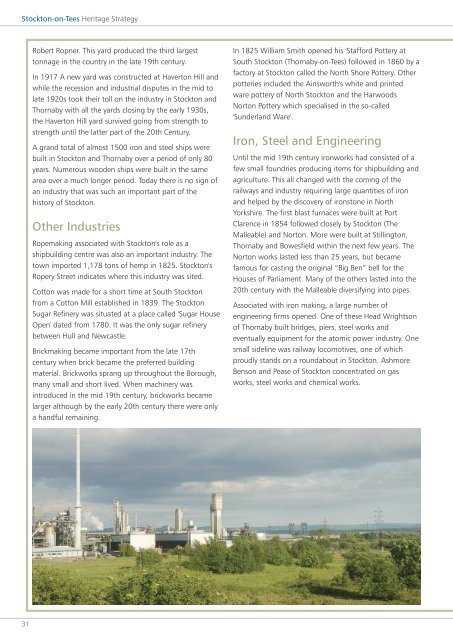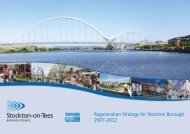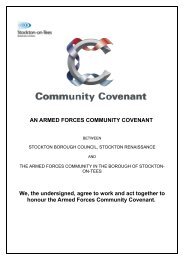Heritage Strategy - Stockton-on-Tees Borough Council
Heritage Strategy - Stockton-on-Tees Borough Council
Heritage Strategy - Stockton-on-Tees Borough Council
You also want an ePaper? Increase the reach of your titles
YUMPU automatically turns print PDFs into web optimized ePapers that Google loves.
stockt<strong>on</strong>-<strong>on</strong>-<strong>Tees</strong> <str<strong>on</strong>g>Heritage</str<strong>on</strong>g> <str<strong>on</strong>g>Strategy</str<strong>on</strong>g><br />
Robert Ropner. This yard produced the third largest<br />
t<strong>on</strong>nage in the country in the late 19th century.<br />
In 1917 A new yard was c<strong>on</strong>structed at Havert<strong>on</strong> Hill and<br />
while the recessi<strong>on</strong> and industrial disputes in the mid to<br />
late 1920s took their toll <strong>on</strong> the industry in <str<strong>on</strong>g>Stockt<strong>on</strong></str<strong>on</strong>g> and<br />
Thornaby with all the yards closing by the early 1930s,<br />
the Havert<strong>on</strong> Hill yard survived going from strength to<br />
strength until the latter part of the 20th Century.<br />
A grand total of almost 1500 ir<strong>on</strong> and steel ships were<br />
built in <str<strong>on</strong>g>Stockt<strong>on</strong></str<strong>on</strong>g> and Thornaby over a period of <strong>on</strong>ly 80<br />
years. Numerous wooden ships were built in the same<br />
area over a much l<strong>on</strong>ger period. Today there is no sign of<br />
an industry that was such an important part of the<br />
history of <str<strong>on</strong>g>Stockt<strong>on</strong></str<strong>on</strong>g>.<br />
Other industries<br />
Ropemaking associated with <str<strong>on</strong>g>Stockt<strong>on</strong></str<strong>on</strong>g>'s role as a<br />
shipbuilding centre was also an important industry. The<br />
town imported 1,178 t<strong>on</strong>s of hemp in 1825. <str<strong>on</strong>g>Stockt<strong>on</strong></str<strong>on</strong>g>'s<br />
Ropery Street indicates where this industry was sited.<br />
Cott<strong>on</strong> was made for a short time at South <str<strong>on</strong>g>Stockt<strong>on</strong></str<strong>on</strong>g><br />
from a Cott<strong>on</strong> Mill established in 1839. The <str<strong>on</strong>g>Stockt<strong>on</strong></str<strong>on</strong>g><br />
Sugar Refinery was situated at a place called 'Sugar House<br />
Open' dated from 1780. It was the <strong>on</strong>ly sugar refinery<br />
between Hull and Newcastle.<br />
Brickmaking became important from the late 17th<br />
century when brick became the preferred building<br />
material. Brickworks sprang up throughout the <strong>Borough</strong>,<br />
many small and short lived. When machinery was<br />
introduced in the mid 19th century, brickworks became<br />
larger although by the early 20th century there were <strong>on</strong>ly<br />
a handful remaining.<br />
In 1825 William Smith opened his 'Stafford Pottery at<br />
South <str<strong>on</strong>g>Stockt<strong>on</strong></str<strong>on</strong>g> (Thornaby-<strong>on</strong>-<strong>Tees</strong>) followed in 1860 by a<br />
factory at <str<strong>on</strong>g>Stockt<strong>on</strong></str<strong>on</strong>g> called the North Shore Pottery. Other<br />
potteries included the Ainsworth's white and printed<br />
ware pottery of North <str<strong>on</strong>g>Stockt<strong>on</strong></str<strong>on</strong>g> and the Harwoods<br />
Nort<strong>on</strong> Pottery which specialised in the so-called<br />
'Sunderland Ware'.<br />
ir<strong>on</strong>, steel and engineering<br />
Until the mid 19th century ir<strong>on</strong>works had c<strong>on</strong>sisted of a<br />
few small foundries producing items for shipbuilding and<br />
agriculture. This all changed with the coming of the<br />
railways and industry requiring large quantities of ir<strong>on</strong><br />
and helped by the discovery of ir<strong>on</strong>st<strong>on</strong>e in North<br />
Yorkshire. The first blast furnaces were built at Port<br />
Clarence in 1854 followed closely by <str<strong>on</strong>g>Stockt<strong>on</strong></str<strong>on</strong>g> (The<br />
Malleable) and Nort<strong>on</strong>. More were built at Stillingt<strong>on</strong>,<br />
Thornaby and Bowesfield within the next few years. The<br />
Nort<strong>on</strong> works lasted less than 25 years, but became<br />
famous for casting the original “Big Ben” bell for the<br />
Houses of Parliament. Many of the others lasted into the<br />
20th century with the Malleable diversifying into pipes.<br />
Associated with ir<strong>on</strong> making, a large number of<br />
engineering firms opened. One of these Head Wrights<strong>on</strong><br />
of Thornaby built bridges, piers, steel works and<br />
eventually equipment for the atomic power industry. One<br />
small sideline was railway locomotives, <strong>on</strong>e of which<br />
proudly stands <strong>on</strong> a roundabout in <str<strong>on</strong>g>Stockt<strong>on</strong></str<strong>on</strong>g>. Ashmore<br />
Bens<strong>on</strong> and Pease of <str<strong>on</strong>g>Stockt<strong>on</strong></str<strong>on</strong>g> c<strong>on</strong>centrated <strong>on</strong> gas<br />
works, steel works and chemical works.<br />
ICI<br />
31

















